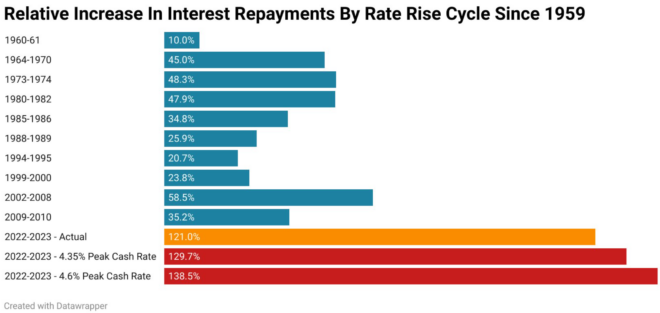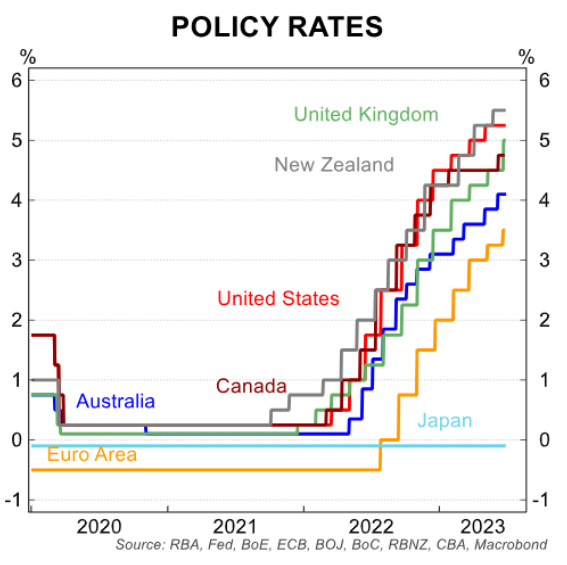The Reserve Bank of Australia (RBA) has hiked the official cash rate by 4% in just 13 months, the country’s steepest and largest monetary tightening in history:

According to data released last month by independent economist Tarric Brooker, the RBA’s rate hikes have increased mortgage interest repayments by an unprecedented 121%, which would increase to 138.5% if rates were raised twice more (as predicted by Westpac, NAB and ANZ):

The pain inflicted on Australian mortgage borrowers is unrivaled in the world.
Although the RBA has hiked interest rates less than other English-speaking central banks:

Because the vast majority of Australians have variable-rate mortgages, the rise in average mortgage rates in Australia has been substantially greater.
According to the RBA chart below, Australian mortgage borrowers had seen more than 200 basis points of mortgage tightening as of February, far more than in other English-speaking countries:

So, when official interest rates rise (or fall), most other countries’ mortgage holders are not as affected as Australians.
RBA is slaughtering Australian mortgage holders:
The Bank for International Settlements (BIS) publishes a dataset in which aggregate debt repayments (principal and interest) are compared to aggregate household disposable income in various countries.
According to the chart below, at the end of 2022, Australian consumers spent 16.3% of their disposable income on debt repayments, up from 13.5% in the March quarter preceding the RBA’s first rate hike:

Australia’s increase in debt payment expenses has also outpaced those of the other English-speaking countries assessed by the BIS, again reflecting the fact that most Australians are on variable rate mortgages.
Separate data released on Friday by the RBA likewise showed that scheduled principal and interest mortgage repayments as a share of household disposable income was 8.5% at the end of 2022, just below the peak of 9.0% at the end of 2010:

The official Australian cash rate at the end of 2022 was 3.10%.
As a result, the two charts immediately above do not account for an additional 100 basis points of tightening, as well as the expiration of fixed-rate mortgages, which have increased debt repayments further but are not captured.
It is also worth mentioning that mortgages are held by slightly more than one-third of Australian households, which explains why just 13.5% of aggregate family income was dedicated to debt repayments by the end of 2022 according to the BIS, while the RBA says scheduled mortgage repayments were only 9.5% of household income.
As a result, the impact on mortgage-holding households is far worse.
Indeed, the RBA’s historic monetary tightening has almost entirely impacted mortgaged homeowners rather than the wider population.
Prepare for more mortgage pain:
The situation for Australian mortgage holders will only worsen from here.
To begin with, the RBA is widely expected to hike interest rates further in the coming months, increasing repayments.
The CBA’s economics team now expects the RBA to raise the top rate by 25 basis points in August to 4.35%, with a possible further increase on Tuesday if data permits.
Westpac, ANZ, and NAB all predict the RBA to boost interest rates by 25 basis points to 4.60% in July and August.
Second, around 500,000 fixed-rate mortgages will expire over the second half of this year, causing borrowers to reset from mortgage rates of roughly 2% to variable rates of up to 7% (or higher if the RBA continues to raise interest rates):

Therefore, even in the unlikely event that the RBA does not raise the official cash rate further from here, average mortgage rates (and repayments) in Australia will continue to grow.
The following chart from CBA’s economics team is concerning in this regard:

Mortgage repayments will hit an all-time high share of household income in 2024, according to RBA projections.
These repayments will easily exceed what other countries’ mortgage holders pay, confirming that Australia the worst place in the world to have a mortgage.

